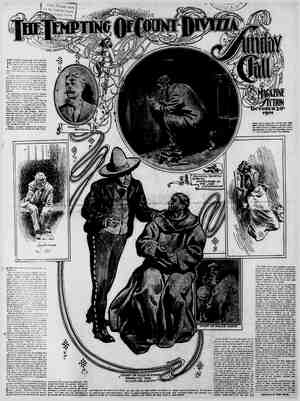The San Francisco Call. Newspaper, October 20, 1901, Page 11
You have reached the hourly page view limit. Unlock higher limit to our entire archive!
Subscribers enjoy higher page view limit, downloads, and exclusive features.
FOUNTAIM LION FLOUNTAIN LIOW __ lifornia have that Ernest Beton- But Mr Putnam ng Thomy hag chos erpre . He is now using ciay ward to the greater per- idio here in the midst e mountain lions and ars in clay and bronze peer shelf. Mr. a ranch near getting acquaint- of these figures. Putnam made his headquarters on From the ranch he made frequent excur- stons bac the mountaine. He camped and above all he watched. d the and bunted, He watche mountain lons every he could get a their poses, 1 catlike. e cat paws are, iscles, how plercing thelr eyes. He learned their moods, too, and those moods are many. Then, with all the phases of them indelibly impressed upon his mind, he went back to his work. shop and proceeded to make mountain lons. He has a menagerie of them now in his studio. There are angry ones and calm ones, but In every one can be feit the sav- age power lurking behind even a sleeping extericr. There is a hidden alertness un~ der the calm. There {s quite as much to fear in the one lying comfortably on the ground, apparently ready to settle down for a nap, as in the flercely growling one with teeth displayed. The coyotes are acquaintances of his, too. He has seen them skulk away and he has reproduced that skulk. There is a little fellow sneaking off with his tall between his legs in typical wolf fashion, The backward glance, the nervous hurry of the whole figure, show a close knowl- edge of the ways of this anfmal that is as cunning as the fox, as cowardly as only himself. The leanness of him shows the frugality of his desert sustenance that makes many a dinner on one tiny lzard for wainj of finding any bigger game that in sick or hurt enough to offer no resist. ance, Another eonu & small figure of white clay, has a how!l raised to the heavens above, There are some figures of black bears. One clever character study is of a mother bear and cub frolicking gayly in roly- "COWBOY AND BRONCHO THE SUNDAY CALL. poly bear fashion. The cub is standing erect, batting the mother with both paws. She is rolled upon her back and is batting back, all feet in the air, The lynx kitten is a lesson iIn natural history to most.people, for it is safe to say that very fow of us know what a 1ynx kitten looks Uke. It is softly hunched up, catlike; its body is soft and plump, for it has not grown lean with the re- sponsibility of foraging for itself, and its tail is round and short and curled. Putnam's love for horses shows in his studies of bronchos. He lived long enough on tho southern ranch to become pretty thoroughly acquainted with them, and JMOUNTAWS MI10M. with the men who ride them as weil. He has made studies of them'in colors, but the art of the sculptor is the one he al- ways returns to as his favorite means of execution. A lvely coit in clay, a young broncho, shows great action, its head tossing end a wild scamper evidently in prospect. Another broncho, with a cowboy on his back, is loafing during a lazy Interval in the cow-punching profession. In fact, both of them are loafing—the cowboy with his leg thrown over the pommel of the saddle, and the horse brushing flles from his forelegs with head down. The whole s the picture of a warm, lusy aft- ernoon. Arthur Putgam has not always been at work with clav. He could not afford to give up his time to modeling until two years ago. He had his own way to make, and art in its early phases is not a bread and butter proposition, so he tried u lit- ‘tle of everything that was “prosaic and money-making and uninteresting. Now he has set himself up in a San Francisco studio, and he is making up with a will for all the lost time of those years when he was pot-boiling. 11 e — Dark green hangings soften the light and serve as 1 relief to the ghostly white inhabitants of that great room. There the animals are perched in every conceivabla nook and corner. There, too, are human figures, for Putnam does not confine him- self to animals, good friend of them though he is. “It isn't so very different all, working from human models,” he says. “There's a good deal about people that is just like the animals.” And a good deal of the human in beasts, Judging from the character studies he has to show. The cowardice of the coyote, the cruelty of the lion, the playfulness gnd mother-love of the bear—they are all human enough. Putnam is trying his hand at other ani- mals, too, besides those of Cailfornia. He has a study of an Hastern lion and an- other of a tiger and a serpent gripped in deadly confiiet. Putnam is young and his work is only begun as yet. He has begun honestly, that is the great thing. Ha is reprodue- ing What he has seen with his own eyes. and with no other man's. Which is not so common a way, When you come to think of it. COMSTOCK. after

